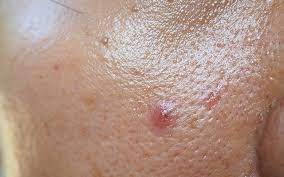Oily skin is a common dermatologic concern reported by all types of patients, including those without acne, given its association with larger facial pores and an “unclean” or “greasy” appearance. Numerous factors play a role in the pathogenesis of oily skin.
Oil on the skin is basically the sebum secreted by sebaceous glands. These glands are highly concentrated behind the ear and on the face, upper chest, and back. The major cells comprising sebaceous glands are sebocytes, and these cells disintegrate and release sebum via holocrine secretion. Sebum is a viscous fluid composed of squalene, wax esters, triglycerides, free fatty acids, cholesterol esters, and free sterols.
Sebaceous glands are present at birth and display relatively high production of sebum at this time. Shortly after birth, sebum production decreases until puberty, at which time it dramatically increases. Sebum production does not decline again until after menopause for women and around the sixth to seventh decade for men.

The average rate of sebum production in adults is 1mg/10cm2 every three hours, when it exceeds 1.5mg/10cm2 every three hours it results in oily skin. Various factors are responsible for oily skin. Men in general have higher sebum output, attributed to higher testosterone levels, although sebum production does increase during ovulation in women, likely secondary to increased progesterone.
Sebum production varies according to the environment; several studies have described an increase in sebum production during the spring and summer and more in humid climates. Chinese women display notably smaller pore sizes and lower densities, while black individuals have enlarged pore sizes that can be attributed to higher rates of sebum output.
A few general tips to help oily skin
- DO wash your face every morning, evening, and after exercise. While washing, resist the temptation to scrub your skin, even to remove makeup. Scrubbing irritates your skin, which can make it look worse.
- DO choose skin care products that are labelled “oil-free” and “noncomedogenic.” This means that products that have these labels – including cleansers, moisturizers and makeup—won’t clog your pores or cause acne.
- DO use a gentle, foaming face wash. Many people believe that they need to use a strong face wash for oily skin in order to dry out their skin. However, using a face wash that is too harsh can irritate your skin and trigger increased oil production. Instead, look for a mild, gentle face wash.
- DON’T use oil-based or alcohol-based cleansers. These can irritate your skin.
- DO apply moisturizer daily. Although you have oily skin, it is still important to apply moisturizer to keep your skin hydrated. To save time and protect your skin from the sun’s harmful ultraviolet rays, look for a moisturizer that also contains a broad-spectrum sunscreen with an SPF of 30 or higher.
- DO wear sunscreen outdoors. Sunscreen helps prevent sun damage that could lead to wrinkles, age spots, and even skin cancer. To prevent acne breakouts, look for sunscreens that contain zinc oxide and titanium dioxide, and do not use sunscreens that contain fragrances or oils.
- DO choose oil-free, water-based makeup.
- DON’T sleep in your makeup. Always remove all makeup before going to sleep.
- DO use blotting papers throughout the day. Gently press the paper against your face and leave it on for a few seconds to absorb the oil. Don’t rub the paper on your face, as this will spread the oil to other areas.
- DON’T touch your face throughout the day. Although it’s tempting to touch your face, doing so can spread dirt, oil, and bacteria from your hands to your face. Only touch your face when you’re cleansing, moisturizing or applying sunscreen or makeup, and make sure your hands are clean first.
In spite of following general instructions, if excess oil production is a problem, then it is time to consult a dermatologist. Below are a few options available for treating oily skin.
Topical treatments for oily skin
Retinoids: They are vitamin A derivatives; their effects on the skin are mediated by their interaction with specific nucleic acid receptors. They reduce sebocyte proliferation, differentiation, and the synthesis of sebum, few retinoids reduce pore size.
Olumacostat glasaretil(DRM01): It’s a topical sebum production inhibitor, which inhibits the synthesis of fatty acids, which make up the majority of sebum.
Cosmeceuticals: Topical 2% niacinamide reduces sebum secretion. 3% green tea emulsion application has also been shown to reduce sebum secretion. Topical 2% L-carnitine has been shown to significantly decrease intracellular fatty acid content in human sebocytes and result in significant sebum reduction.
Chemical peels: Superficial chemical peels with alpha-hydroxy acid (glycolic acid) or beta-hydroxy acid (salicylic acid) produce sebum reduction. Three to four treatments will help reduce sebum and improve clogged pores.
Systemic treatment:
Isotretinoin: Oral retinoids cause the greatest reduction of sebum. Sebum production decreases by 90%; low-dose isotretinoin (0.5 mg/kg) could be given to treat oily skin.
Spironolactone: It reduces sebum production and is used in a range of 50 to 200 mg daily. It also functions as an androgen receptor blocker and prevents androgen action on sebocyte proliferation.
Oral contraceptives: They result in a decrease in ovarian and adrenal androgens, thereby reducing sebum production. Oestrogens inhibit excessive sebaceous gland activity.
Other treatments:
Botulinum toxin: Studies with intradermal botox injections on the forehead and T zone of the face have shown reduced sebum production. They act by reducing neurotransmission within sebocytes, thereby reducing sebocyte differentiation and production.
Photodynamic therapy: It involves the application of δ-aminolevulinic acid (ala), which is absorbed by sebocytes, and upon exposure to light of a certain wavelength, the sebocytes are destroyed, leading to reduced sebum production.
Laser: 1450 nm diode laser has shown better results in sebum reduction after 3 to 4 sessions.
Do contact us at the Venkat Center Bangalore for any more queries.
